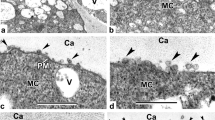Summary
Arenaria musciformis.—A lenticular generative cell is organised in the 2-nucleate pollen grain. The ripe pollen grain in the anther is either 2-nucleate or 3-nucleate and the two male nuclei are spherical in form but unequal in size. A fully-formed embryo-sac is, as usual, 8-nucleate and of the normal organisation.
Thylacospermum rupifragum.—A definite generative cell is formed in the 2-nucleate pollen grain. The ripe pollen grain in the anther is invariably found to be only 2-nucleate. A fully formed embryo-sac differs from the normal one ofArenaria mainly in the structure of its egg-apparatus— the synergids possess lateral hooks and exceed the egg in the size of the cell. In the seed, the embryo, lying curved on one side of the perisperm, is embedded in a complete sheath of endosperm, two to four cells thick.
A marked feature of the life-histories ofArenaria andThylacospermum is the large amount of degeneration in both the pollen grains and the embryo-sacs.
Similar content being viewed by others
Literature cited
Bhargava, H. R., “The life-history ofChenopodium album L.,”Proc. Ind. Acad. Sci., 1936,4, 179–200.
Gibbs, L. S., “Notes on the development and structure of the seed in the Alsinoideæ,”Ann. Bot., 1907,21, 25–55.
Hooker, J. D.,Flora of British India, London, 1875,1.
Jeffrey, E. C., “Spore conditions in hybrids and the mutation hypothesis of De Vries,”Bot. Gas., 1914,58, 322–336.
Johansen, D. A., “Studies on the morphology of the Onagraceæ,”Amer. Jour. Bot., 1931,18, 854–863.
Joshi, P. C., “Contribution to the life-history ofStellaria media L.,”Proc. Ind. Acad. Sci., 1936,3, 8–22.
Joshi, P. C., “Anatomy of the vegetative parts of two Tibetan Caryophyllaceæ—Arenaria musciformis Wall., andThylacospcrmum rupifragum Schrenk.,”Proc. Ind. Acad. Sci., 1936,4, 52–65.
Madge, A. P., “Spermatogenesis and fertilization in the cleistogamous flower ofViola odorata,”Ann. Bot., 1929,43, 545–577.
Rocén, T.,Zur Embryologie der Centrospermen, Uppsala, 1927.
Schnarf, K.,Embryologie der Angiospermen, Berlin, 1929.
Schnarf, K.,Vergleichende Embryologie der Angiospermen, Berlin, 1931.
Weinstein, A. I., “Cytological studies onPhaseolus vulgaris,”Amer. Jour. Bot., 1926,13, 248–263.
West, G., “Cleistogamy inViola riviniana, with especial reference to its cytological aspects,”Ann. Bot., 1930,44, 87–109.
Woodcock, E. F., “Seed development inThelygonium cynocrambe L.,”Papers Michigan Acad. Sci. Arts Letts., 1929,11, 341–347.
Author information
Authors and Affiliations
Additional information
Communicated by Dr. H. Chaudhuri.
The writer is highly indebted to Dr. S. L,. Ghose for his keen interest and encouragement during the course of the investigation. Sincere thanks are due to Mr. A. C. Joshi of the Benares Hindu University for several valuable suggestions and criticisms.
Rights and permissions
About this article
Cite this article
Joshi, P.C. Some phases of the life-history of two Tibetan caryophyllaceÆ—Arenaria musciformis Wall. andThylacospermum rupifragum Schrenk. Proc. Indian Acad. Sci. 4, 471–482 (1936). https://doi.org/10.1007/BF03051420
Received:
Issue Date:
DOI: https://doi.org/10.1007/BF03051420




